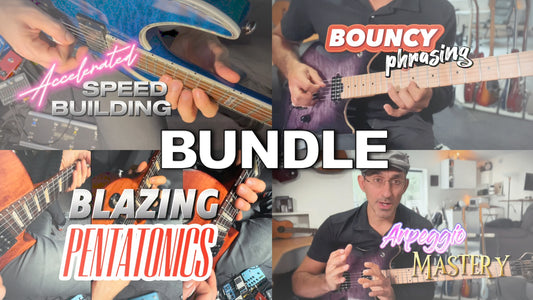A Better Way to Learn Chords and Chord Progressions
Share
A Better Way to Learn Chords and Chord Progressions
Okay, so you probably looked at that and thought, “Nice, that’s a new chord I can learn. What’s it called?” But if you’re asking that question, you’re approaching it the wrong way. Let me explain why and show you a better method that will help you learn tons of new chords and progressions.
I upload a lot of videos. The feedback I get from you is awesome because it helps me gauge where people are in their guitar playing journey. But there’s one thing that struck me as interesting. When I show a riff or a vamp based around a specific chord, I often get the question, “What’s the name of that chord?” And to be honest, that doesn’t always make sense to me.
The Problem with Chord Names
It’s great to know the names of chords, of course. You can look up a chord chart, find the name, and play the song. That’s all good stuff. But as you become more advanced and learn more voicings, simply memorizing chord names becomes less useful. Why? Because there are more chords and voicings on the guitar than you’ll ever be able to explore and memorize in a lifetime. There are too many combinations!
So, there’s a better approach to learning chords. Instead of focusing on memorizing chord names, try understanding why a chord is useful. That’s exactly what I want to show you today, using a very simple chord progression.
Chord Progressions Over Chord Names
Let’s take a look at a simple chord progression that I showed you earlier. A lot of people would just memorize it as a new interesting chord, which is fine. We could break it down and analyze it. For example, we might say it starts with an E and then goes down to an E power chord with an E-flat in the bass. But things get complicated really fast.
Instead of focusing on the specific chord name, I think it’s more useful to think about the movement from one chord to another. There’s a bass movement happening here, and we can adapt our chord shape to follow that movement. The important part is the flow—the smooth transition from one chord to the next. In this case, I simply included the bass note in the chord shape to create a natural progression. That’s what I want to remember and focus on.
Don’t Overthink the Theory
My point here is that it doesn’t really matter if what you’re playing is complicated or based on power chords. You don’t always need to be theoretical about everything and memorize every chord name. Instead, have a basic knowledge of a few key chords and then apply your ears and common sense. What can you add to that chord to make it sound better?
For example, I could start with a simple D chord, and then I just move one finger to change the sound. It’s not about knowing the name of the chord—it’s about experimenting and opening your mind to new possibilities.
If you start thinking about chord progressions this way, you’ll open yourself up to new ideas and approaches to the chords you already know. It’ll help you move past the obsession with whether a chord is “correct” or not. Does it have a name? Sure. But that’s not the point. The point is experimenting, exploring, and creating new sounds at your own pace.
Conclusion: Explore and Experiment
Don’t get bogged down by naming chords or worrying about if your chord is "correct." Explore the fretboard, trust your ears, and experiment with what sounds good. The more you explore and understand why certain chords work together, the faster you’ll develop your own unique sound.
--Kris



